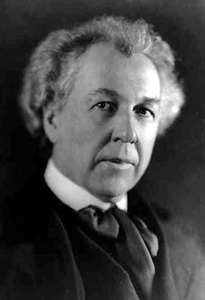 August 26, 1927
August 26, 1927
Madison, Wisc.
Frank Lloyd Wright was a favorite son of Los Angeles, where he threw off the Prairie mantle and began creating his kooky indigenous-flavored block houses (e.g., Storer, Millard, Ennis, Freeman) in contrast to the Spanish Colonial (or, say, Egyptoid Tudor Chateauxesque) prevalent in the Southland’s early 20s, before he said to hell with LA and lit out for his cursed home, Taliesin.
There was much architectural buzz about Mr. Wright in 1927, as he’d already designed a theater model for Aline Barnsdall, who announced in January that she’d build the structure as part of her eight-acre “city cultural center” gift to Los Angeles of her own FLW Hollyhock House and property.
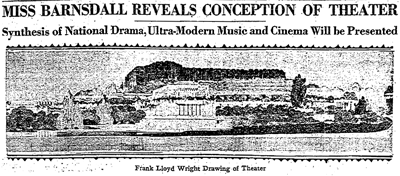
When the Smart People of to-day tour FLW’s block houses and consider his play of light over form, and gauge its relationship between the zig of Meiji woodblock prints and the zag of Walter Burley Griffin’s green thumb, they probably aren’t informed that ol’ FLW had a lurid past fit for any tabloid-worthy favorite son of Los Angeles.
For example, while married to Catherine Wright, he fell in love with another woman, one Mamah Borthwick. Catherine wouldn’t divorce him, so Wright abandoned her and the six kids and went galavanting around Europe with Mamah. On his return, Catherine still wouldn’t divorce him, so Wright brought scandal to Spring Green, Wisc. by shacking up with Mamah. This was sorted out in short order when one of his domestics decided to utilize a Wrightian architectural principal—one door for all purposes—which made it easy to axe-murder seven people trying to flee a Taliesin you’d just set on fire. And Mamah was one of those so axed.
Catherine finally divorced Frank in 1922 on charges of desertion, so he could marry his new love, a morphine addict named Miriam Noel. They married in 1923, separated in 1924; Wright began seeing Petrograd Ballet dancer Olgivanna Lazovich Milanov (thirty-three years his junior) in 1925 and was thereafter arrested in 1926 for violating the Mann (White-Slave Traffic) Act. Oh, and Taliesin burned again, though this time without anybody being hacked to bits.
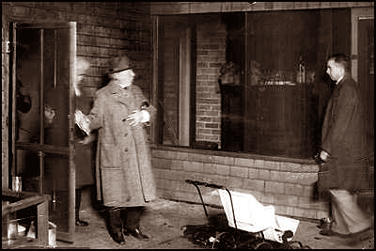
Frank getting popped by the feds, 1926
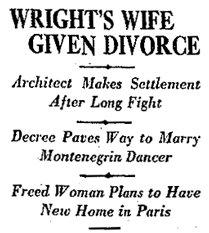 The lucky Wright-drama followers of 1927 were treated to tales of Frank and Miriam’s divorce. Today, Miriam was awarded $6,000 ($66,179 USD2006) immediately, $30,000 (330,889) in trust, and $250 (2,757) a month for life. The cash settlement and Wright’s promise that he "would lead a moral life" preceded the court decree.
The lucky Wright-drama followers of 1927 were treated to tales of Frank and Miriam’s divorce. Today, Miriam was awarded $6,000 ($66,179 USD2006) immediately, $30,000 (330,889) in trust, and $250 (2,757) a month for life. The cash settlement and Wright’s promise that he "would lead a moral life" preceded the court decree.
With a cushy settlement like that, you’d think that’s the last we hear of Miss Miriam. You’d be wrong. She spends the next few years loudly proclaiming Wright’s brutality and repellant morals, with much effort expended in Washington attempting to get Olga deported. In a typical Miriam moment, July 14, 1928, she is arrested on a charge of malicious mischief after breaking 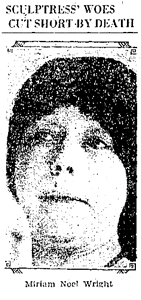 into FLW’s rented La Jolla home while he’s up in Los Angeles: “So thorough was the wrecking that the colored maid in charge of the house in Wright’s absence collapsed from the shock and was taken to the Scripps Memorial Hospital. ‘About fifteen minutes more and I would have leveled the place,’ Mrs. Wright is said to have told police when arrested…damage to the La Jolla home is estimated at about $1000…Mrs. Wright smiling pleaded guilty and following the court action, swore out complaints against her husband and Olga Hinzenberg, also known as Olga Milanoff, charging them with being lewd and dissolute persons.”
into FLW’s rented La Jolla home while he’s up in Los Angeles: “So thorough was the wrecking that the colored maid in charge of the house in Wright’s absence collapsed from the shock and was taken to the Scripps Memorial Hospital. ‘About fifteen minutes more and I would have leveled the place,’ Mrs. Wright is said to have told police when arrested…damage to the La Jolla home is estimated at about $1000…Mrs. Wright smiling pleaded guilty and following the court action, swore out complaints against her husband and Olga Hinzenberg, also known as Olga Milanoff, charging them with being lewd and dissolute persons.”
Miriam finally expires in 1930.
We’ll keep you posted on all breaking FLW news.
I’d keep an eye on that Schindler character if I were you.




 Dorothy Parker’s well-known verse, published in her 1926 collection Enough Rope, assured readers that they "might as well live." However, this admonition proved impossible for many today in the Southland, as three men turned blades upon themselves in a veritable rash of unrelated suicides.
Dorothy Parker’s well-known verse, published in her 1926 collection Enough Rope, assured readers that they "might as well live." However, this admonition proved impossible for many today in the Southland, as three men turned blades upon themselves in a veritable rash of unrelated suicides.





 August 26, 1927
August 26, 1927

 The lucky Wright-drama followers of 1927 were treated to tales of Frank and Miriam’s divorce. Today, Miriam was awarded $6,000 ($66,179 USD2006) immediately, $30,000 (330,889) in trust, and $250 (2,757) a month for life. The cash settlement and Wright’s promise that he "would lead a moral life" preceded the court decree.
The lucky Wright-drama followers of 1927 were treated to tales of Frank and Miriam’s divorce. Today, Miriam was awarded $6,000 ($66,179 USD2006) immediately, $30,000 (330,889) in trust, and $250 (2,757) a month for life. The cash settlement and Wright’s promise that he "would lead a moral life" preceded the court decree. into FLW’s rented La Jolla home while he’s up in Los Angeles: “So thorough was the wrecking that the colored maid in charge of the house in Wright’s absence collapsed from the shock and was taken to the Scripps Memorial Hospital. ‘About fifteen minutes more and I would have leveled the place,’ Mrs. Wright is said to have told police when arrested…damage to the La Jolla home is estimated at about $1000…Mrs. Wright smiling pleaded guilty and following the court action, swore out complaints against her husband and Olga Hinzenberg, also known as Olga Milanoff, charging them with being lewd and dissolute persons.”
into FLW’s rented La Jolla home while he’s up in Los Angeles: “So thorough was the wrecking that the colored maid in charge of the house in Wright’s absence collapsed from the shock and was taken to the Scripps Memorial Hospital. ‘About fifteen minutes more and I would have leveled the place,’ Mrs. Wright is said to have told police when arrested…damage to the La Jolla home is estimated at about $1000…Mrs. Wright smiling pleaded guilty and following the court action, swore out complaints against her husband and Olga Hinzenberg, also known as Olga Milanoff, charging them with being lewd and dissolute persons.”